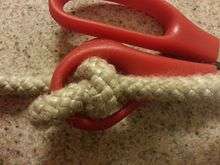Knute hitch
The Knute hitch is used to attach a lanyard of small stuff to a marlingspike or other tool. Rigger Brion Toss named the hitch after his favourite marlingspike of the same name,[1] although the hitch is likely much older.[2]
| Knute hitch | |
|---|---|
 | |
| Category | Hitch |
| Related | Marlinespike hitch |
| Releasing | Non-jamming |
| Typical use | Attaching a lanyard to a tool |
Tying
The lanyard line should be just small enough to fit doubled through the lanyard hole in the tool. This is done, forming a protruding bight. The end, with a figure-eight knot stopper, is placed through the bight but not fully pulled through. Finally, the bight is withdrawn, jamming the bight and line end in the hole. To release, pull on the end and remove it from the bight.
gollark: ++delete any deletions, past and future, which may/have prevent(ed) deletion of dennis richtie
gollark: ++delete any deletion of dennis richties death
gollark: ++delete dennis richtie
gollark: So actually it's only serialized per connection, or something?
gollark: Technically all accesses are serialized except they actually aren't in WAL mode or if you just have multiple connections.
See also
References
- Toss, Brion (1992). The Rigger's Locker - Tools and Techniques for Modern and Traditional Rigging. International Marine. p. 105.
- Budworth, Geoffrey (1999). The Ultimate Encyclopedia of Knots & Ropework. London: Hermes House. p. 102.
External links
This article is issued from Wikipedia. The text is licensed under Creative Commons - Attribution - Sharealike. Additional terms may apply for the media files.